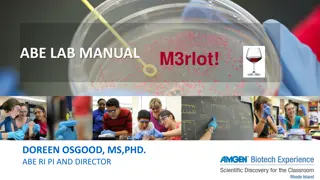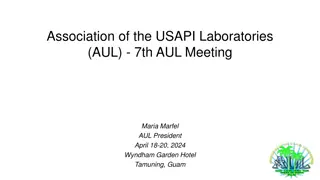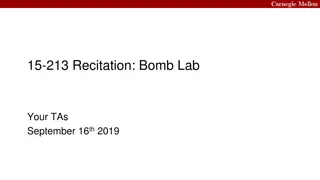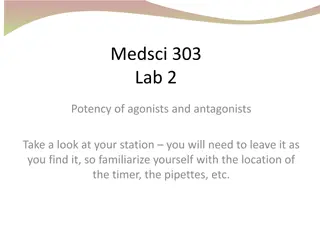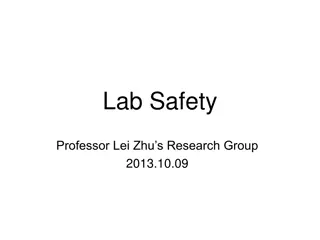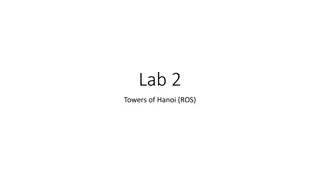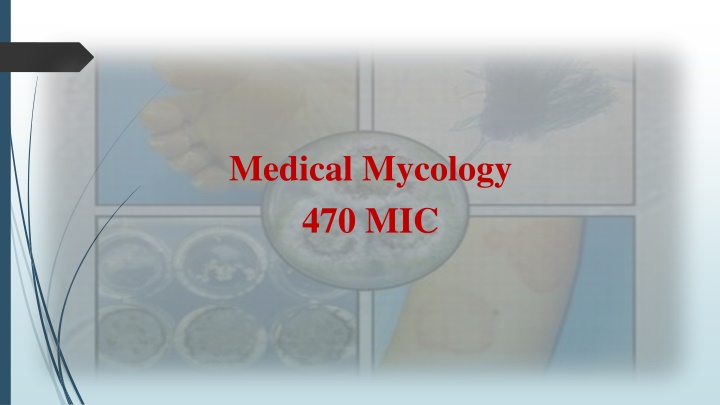
Fungal Infection Diagnostic Techniques in Medical Mycology
"Explore the principles and techniques of diagnosing fungal infections in medical mycology, including preparing fungus media, isolation methods, and adjusting pH levels for optimal fungal growth. Learn about different agar compositions such as Czapek's Agar, Sabouraud Agar, and Potato Dextrose Agar. Enhance your knowledge of clinical procedures for identifying and diagnosing fungal pathogens."
Download Presentation

Please find below an Image/Link to download the presentation.
The content on the website is provided AS IS for your information and personal use only. It may not be sold, licensed, or shared on other websites without obtaining consent from the author. If you encounter any issues during the download, it is possible that the publisher has removed the file from their server.
You are allowed to download the files provided on this website for personal or commercial use, subject to the condition that they are used lawfully. All files are the property of their respective owners.
The content on the website is provided AS IS for your information and personal use only. It may not be sold, licensed, or shared on other websites without obtaining consent from the author.
E N D
Presentation Transcript
Medical Mycology 470 MIC
Medical Mycology In this course we will focus on understanding the principle of some clinical techniques used for the identification and diagnosis of fungal infection.
* Basic steps will be addressed before moving to the diagnostic techniques How to prepare fungus media (CZA and SDA) Isolation
Fungus media 1-Czapek s Agar (CZA) * This is a defined medium primarily for the cultivation of fungi (saprophytic fungi) that are capable of using Sodium Nitrate as their sole source of nitrogen Composition of the (CZA) Ingredients Sucrose Benefits Grams/L 30 a carbohydrate source Sodium nitrate Inorganic source of nitrogen 2 Dipotassium phosphate Magnesium sulfate 1 0.5 Potassium chloride 0.5 Ferrous sulfate 0.01 Final pH Agar added as the solidifying agent 15 Final pH (at 25 C) 7.3 0.2 Distilled Water 1000
Fungus media 2- Sabouraud agar or Sabouraud dextrose agar (SDA) *Type of agar growth medium containing peptones *Commonly used for research and clinical diagnosis Composition of the (SDA) Ingredients Peptone Benefits Grams/L (Enzymatic Digest of Casein and Enzymatic Digest of Animal Tissue) **provide the nitrogen and vitamin source required for fungal growth 10 Dextrose a carbohydrate source which serves as a growth stimulant added as the solidifying agent 40 Agar 15 Final pH ( at 25 C) 5.6 0.2 Distilled Water 1000 ml
Fungus media 3-Potato dextrose agar (PDA) * A general-purpose media for yeasts and fungus * Can be supplemented with antibiotics to inhibit bacterial growth * Use a specified amount of sterile tartaric acid (10%) to lower the pH of this medium which inhibits bacterial growth. Composition of the (PDA) Ingredients Potatoes infusion Benefits Grams/L 200 provides a nutrient base for the growth of most fungi Dextrose a carbohydrate source which serves as a growth stimulant 20 Agar added as the solidifying agent 15 Final pH ( at 25 C) 5.6 0.2 Distilled Water 1000 ml
Weigh all the ingredients (gram/L) Suspend all the ingredients in 1000 ml distilled water. Even though we follow a precise protocol (recipe) to make any media, we still need to make sure that the of this media is suitable for fungal growth. How to adjust the pH? Determine the pH level you have using pH Meter. Add either an acidic or alkaline substance to the media To increase the pH use few drops of (0.1 M) Sodium Hydroxide(NaOH) To lower the pH use few drops of (0.1 M) hydrochloric acid (HCL) PH Adjustment - YouTube
After adjusting the pH Use cotton plug and foil to close the flask (you can use Bottle with cap) Label your flask with: A)Tape that has (your name- media type- date) B)Autoclave tape that changes color upon appropriate sterilization If necessary, use warm water bath to dissolve the medium completely. Sterilize by autoclaving at 15 lbs pressure (121 C) for 20 minutes.
In specific clinical work, when pH 3.5 is required, the medium should be acidified with sterile 10% tartaric acid Antibiotics can be added to create selective culture In this case: Prepare the media as described , autoclave , then add acid/antibiotics And finally pour the media immediately. DO NOT heat the media after adding the acid/antibiotics.
Use a marker to briefly label the edge of petri dishes (name-date- experiment) Example; Haya, 3/9, isolation/ or purification etc ** label the bottom of the plate only, NEVER label the lid Pour the sterile media in petri dishes and wait until the media is completely solidify.
Isolation (from plants/fruits) Under sterile conditions, use the appropriate tools to inoculate part of the fungal growth in suitable media In Microbiology labs, the most common tools used for this purpose is the inoculating needles. Needles can be used if there is visible mycelium/ spores
If you don t see visible mycelium/spores, use sterile scalpel and forceps to cut small section of the rotten tissue and plate it. Incubate at 25-28oC for several days (keep tracking incubated plates to avoid overgrowth).


